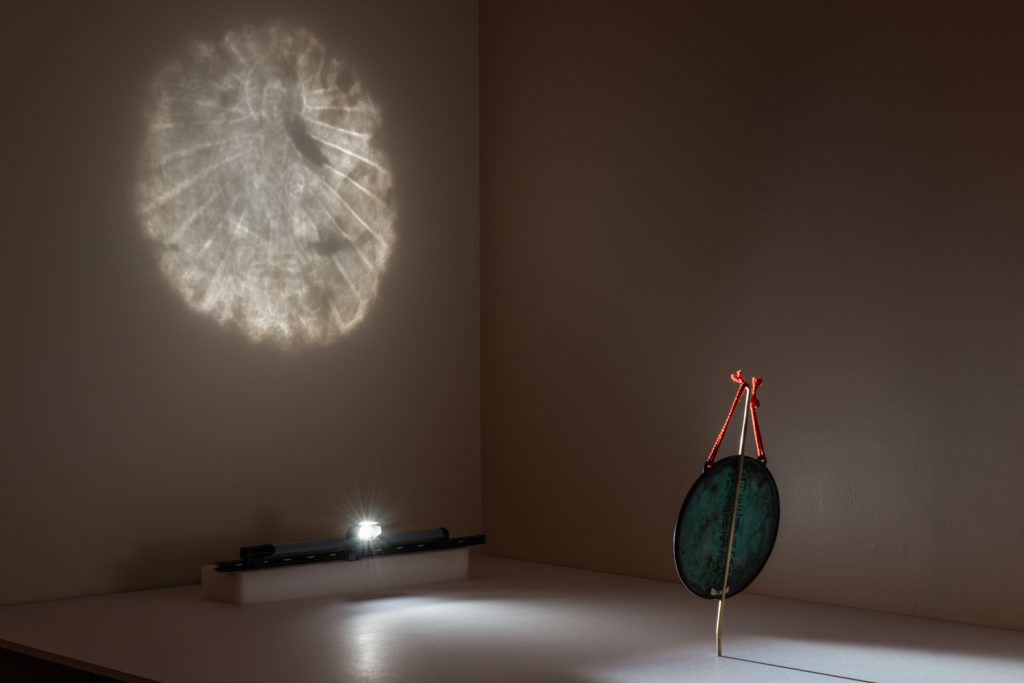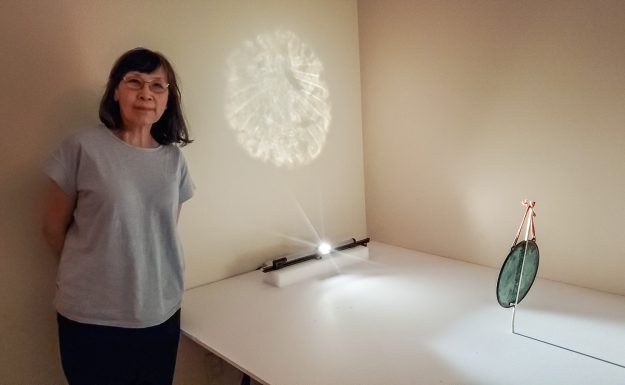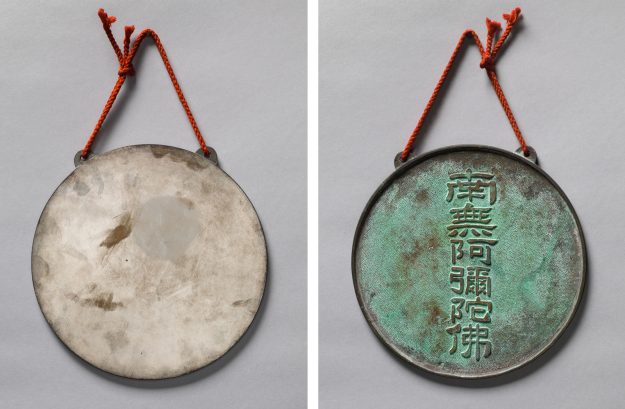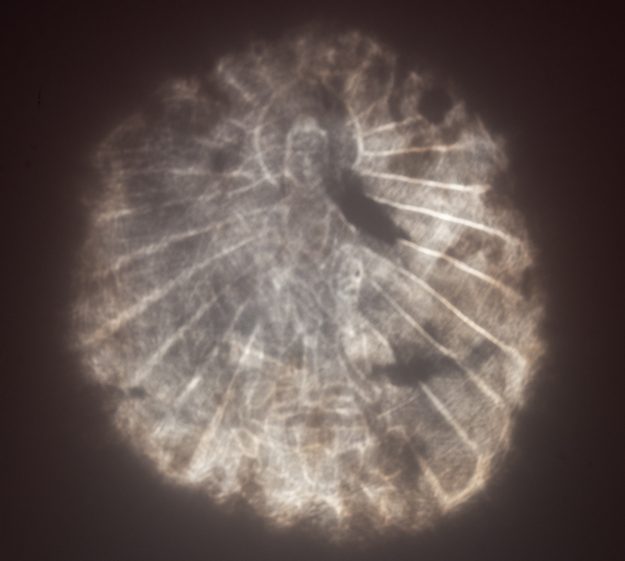This “Magic Mirror” Reveals a Hidden Buddha (If You Know Where to Look)
Art curator Dr. Hou-mei Sung gives us a closer look at a recently displayed Buddhist artifact at the Cincinnati Art Museum. The post This “Magic Mirror” Reveals a Hidden Buddha (If You Know Where to Look) appeared first on...

Art curator Dr. Hou-mei Sung gives us a closer look at a recently displayed Buddhist artifact at the Cincinnati Art Museum.
Interview with Dr. Hou-mei Sung by Faith McMclure Nov 13, 2022 Buddhist Bronze Mirror, 15–16th century, China or Japan, bronze, Source Unknown, Cincinnati Art Museum, x1961.2. | Photograph by Rob Deslongchamps
Buddhist Bronze Mirror, 15–16th century, China or Japan, bronze, Source Unknown, Cincinnati Art Museum, x1961.2. | Photograph by Rob DeslongchampsAt the Cincinnati Art Museum, a rare Buddhist “magic mirror” was found hiding in plain sight this past summer. First accessioned by the museum in 1961, and likely acquired long before that, the seemingly unremarkable bronze mirror had largely gone unnoticed for decades. But a moment of insight from East Asian Art curator Dr. Hou-mei Sung brought this rare Buddhist relic to light—literally. The finely polished mirror appears transparent when light is shined through it, and, as Dr. Sung and her team happily discovered, it projects a hidden image of Amitabha, the Buddha of infinite light.
Amitabha is the central figure of Pure Land Buddhism, a school of Buddhism in which it is believed that reciting Amitabha’s name with sincere devotion will bring rebirth in Sukhavati, or the Pure Land. Dr. Sung believes the mirror was likely used in such ritual prayers, as Amitabha’s name is inscribed on the back.
Exceedingly rare due to the difficulty of the craft, “magic mirrors” like this one have been the subject of both art history papers and scientific research. The discovery makes the museum one of few in the world with such an object.
Tricycle sat down with Dr. Sung to discuss her discovery of the mirror, its art historical background, and its significance within the devotional Pure Land Buddhist tradition.
You happened upon this extremely rare mirror by accident. Tell me how that came about. I was working in our Pan-Asian Buddhist gallery. We had some gaps where we were pulling out something to put it in another gallery, and I was trying to see how I could fill the space and create a little theme. I had found several objects that were related to the Japanese Amida Buddha (the Japanese name for Amitabha). I thought, maybe I can create a corner and just focus on Jodo Buddhism (Pure Land in Japan). I had two Buddhist statues, and then I had this Buddhist mirror. While I was doing research, I discovered there are these so-called “magic mirrors.” So, you know, I was thinking, what if we have one? [Laughing] Out of curiosity, I asked our object conservator to test the mirror. She was so shocked. She said, yes, it is magical! You can imagine how exciting it was. You shine a light on it and suddenly a Buddha image appears from nowhere.
 Hou-mei Sung, Ph.D. 宋后楣, Cincinnati Art Museum’s Curator of East Asian Art is shown next to the Buddhist Bronze Mirror
Hou-mei Sung, Ph.D. 宋后楣, Cincinnati Art Museum’s Curator of East Asian Art is shown next to the Buddhist Bronze MirrorWhere did these mirrors first originate? Were they considered rare in their own time? Magic mirrors are very rare. The origin of the earliest so-called magic mirror was made in China and can be traced to the Han dynasty, second century BC. And at that time, it wasn’t a religious object. The design on the back was a conventional pattern of auspicious characters. They were called transparent mirrors because when they were held against the sunlight, you could see a projection of the design that was on the back of the mirror. Since everybody knows that light cannot penetrate metal, they were considered “magical.” The technology was kept secret to enforce the ruler’s mandate of heaven.
By the Tang dynasty, around the 7th century, they had begun researching how they were made, but then the technology of how to make them was lost by the 13th century. I cannot be absolutely sure of the time, but by the Ming dynasty, I think at about the 15th or 16th century, Buddhist magic mirrors started to appear.
With modern science, we now understand how they’re made and the optic theory, but the reason they’re so rare is because it’s very hard to polish the surface of the design to the point that you can project light through it. How the curvature of the surface projects light differently—it’s not something you can just scientifically control. It takes years of experience to master.
This is one of few magic mirrors known to exist today. The other two you’ve researched are both Japanese, though you suspect this one might be of Chinese origin. Why? Our mirror is very different. On our mirror, of the six characters written on the back (南無阿彌陀佛, the name of Amitabha Buddha), three are written in the traditional Chinese. The two Japanese mirrors use simplified characters, which the Japanese tend to use. That generated my curiosity to check all mirrors with traditional Chinese characters, even if they’re not magical. I found one attributed to the Chinese Ming dynasty that has traditional rather than simplified characters. That’s why it makes me speculate a little more about where it comes from. But are these traditional characters because it’s made earlier, or because it is from a different country? I cannot decide at this point.
 Buddhist Bronze Mirror, 15–16th century, China or Japan, bronze, Source Unknown, Cincinnati Art Museum, x1961.2. | Photograph by Rob Deslongchamps
Buddhist Bronze Mirror, 15–16th century, China or Japan, bronze, Source Unknown, Cincinnati Art Museum, x1961.2. | Photograph by Rob DeslongchampsIn some religious contexts, images of the Buddha are concealed when they’re not in use to preserve the power of the image. Do you see evidence of a similar belief with this mirror? That’s very interesting. The Buddhist magic mirror is different from the Han Chinese mirror, where the projected decoration was visible on the back of the mirror. Instead, the projected image of the Buddha is inside the mirror—it is hidden—and this makes it appear even more magical. There are two metal disks, and inside the front bronze piece on the back is the design. Unless you shine a light on it in a specific way, you can’t see it. That is symbolic, I think, to make this dramatic moment, because the image only appears to you with a certain light and with a certain prayer. As a religious object, I think that is why it became so popular.
The mirror has been considered a sacred object throughout Chinese history. Even regular bronze mirrors in early China were considered “magical” because they were believed to have special powers, like bringing good fortune. Yes, exactly. The mirror was also believed to ward off evil because it reflected light, and this became associated with the power of the mirror. There’s a Chinese term called 照妖鏡, which means “evil spirit reflecting mirror.” You can see how that association also helped to build toward this magical and religious quality of the mirror later on.
Amitabha is known as the Buddha of infinite light (from the Sanskrit amita, meaning “infinite,” and abha, meaning “light”). Do you think the technology of the magic mirror was particularly attractive to Pure Land Buddhists at the time because of the obvious symbolism? It does seem perfect. And Amitabha appears with so many rays of light emanating from him. You may be familiar with the Japanese Amida Raigo paintings, which depict Amitabha descending to the praying believers, giving them strength in their faith. In these images, he comes down from heaven to receive you and to bring you to the Western Paradise. This kind of immediacy, I think, has something to do with the mirror, too. I think the painting is almost a predecessor to the mirror. We know that the Pure Land’s emphasis on invoking Amitabha to reach the Western Paradise inspired the rise of the Amida Raigo paintings, and I am convinced that the same applied to the creation of the Buddhist magic mirror since they served the same function. But I have yet to find records or solid evidence to prove this.
 Photo courtesy of the Cincinnati Art Museum
Photo courtesy of the Cincinnati Art MuseumIn terms of their ritual use, do you think these were hung in temple windows? Yes, I think so. You also notice there are loopholes in the mirror because a mirror like this would typically hang in the temple, and that is a tradition even with or without the magical nature. Also, when you look at the Amida Raigo paintings, it almost looks like there’s a window or an opening in the painting, with the Buddha arriving with a big ray of light.
Do you know the provenance of the mirror? And how has it been received by your audiences? I have my speculations about the provenance, but I dare not make a conclusion. It’s been very popular—probably more popular than all our other exhibits. People really want to see the magic. And I do think it’s kind of a blessing to see it. It gives you hope.
![]()
Thank you for subscribing to Tricycle! As a nonprofit, we depend on readers like you to keep Buddhist teachings and practices widely available.
This article is only for Subscribers!
Subscribe now to read this article and get immediate access to everything else.
Already a subscriber? Log in.

 UsenB
UsenB 

























![Are You Still Optimizing for Rankings? AI Search May Not Care. [Webinar] via @sejournal, @hethr_campbell](https://www.searchenginejournal.com/wp-content/uploads/2025/06/1-1-307.png)






